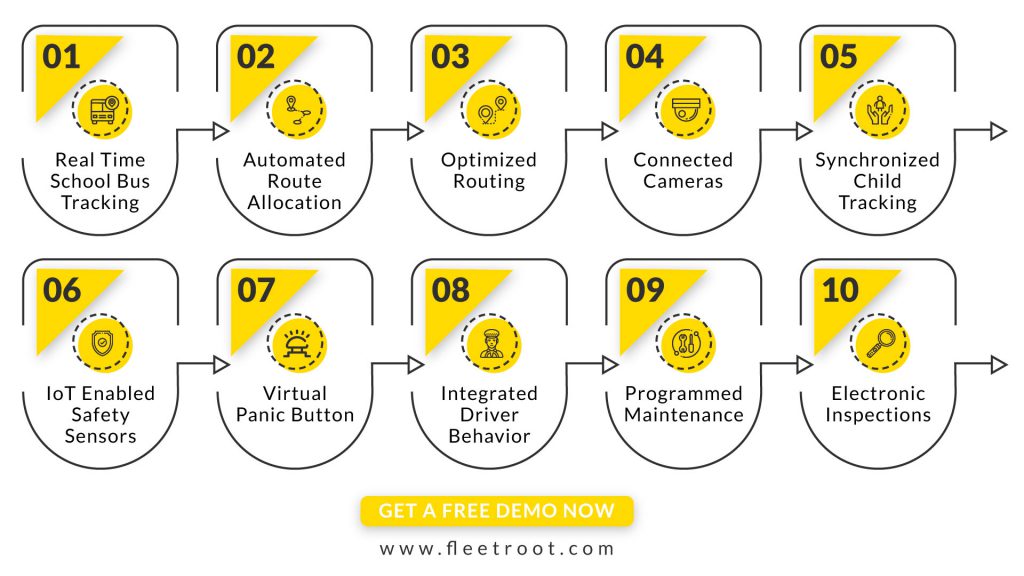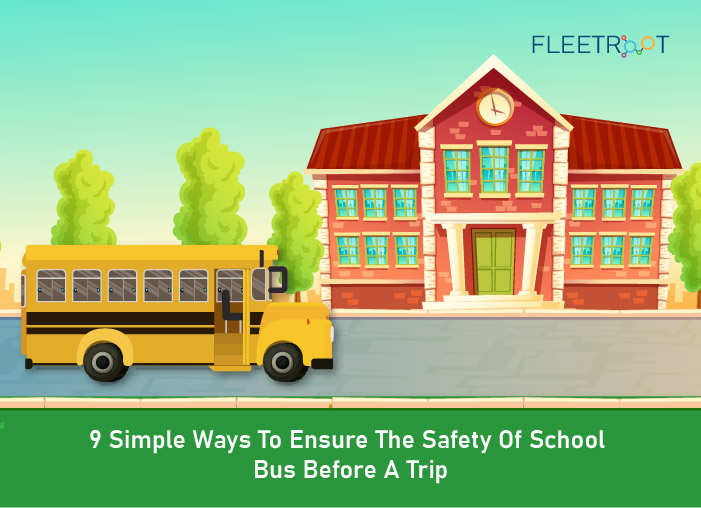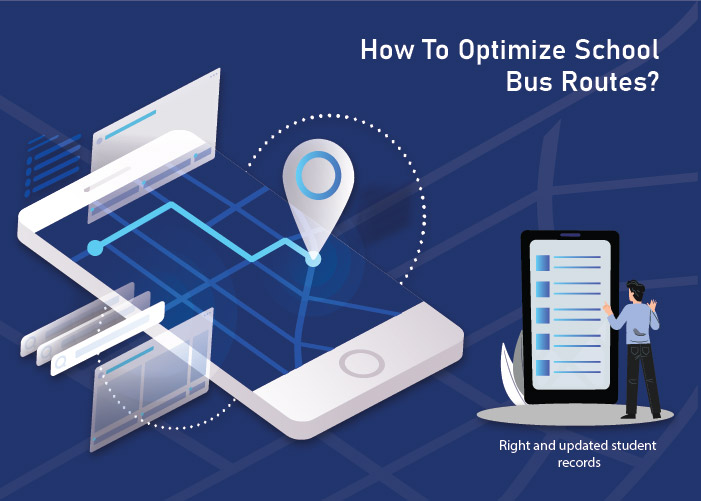School buses have long been considered a safe and efficient means of commute for students, but in recent times, parents concerns have heightened – given the state of road traffic, increased safety threats, and the growing number of accidents due to driver negligence.
Add to that the organic growth in student population due to urbanization and proliferation of school buses, and you realize why traditional school bus management can be a logistics nightmare for schools.
Thankfully, modern day connected school bus technology can make school trips a whole lot more safe, secure and coordinated.
Let us see how:

1.Real Time School Bus Tracking
GPS devices are installed in the school buses to provide real time information on location as well as speed and status of the bus. Further, a cloud-based software is used to integrate this information with a mapping application.
The result is a system in which all stake holders can track the movement of the school bus live, on a map, on their dedicated smart phone app, from anywhere, at any time.
Parents, can get accurate ETA’s so that they can reach the bus stop in time. Transport providers can monitor the movement of all buses on a single map, and can also coordinate on last minute dispatch instructions to drivers in real time. They can make sure drivers stay on their planned routes by setting up alerts for route deviations.
2.Automated Route Allocation
One of the most harrowing jobs of a school bus operator is to allocate students and buses to routes, without causing over loading of the buses.
However, with a modern school bus tracking system, the entire task of route planning and allocation is automated. Auto route allocation feature allocates school buses to routes in the most optimal manner, taking into account seating capacity of vehicles, bus stops and number of students.
The school bus operators simply need to import the student addresses, and specify either the number of buses or maximum route time, and the system automatically calculates the most efficient routes, in terms of bus capacity utilization as well as student convenience.
A student’s absence or any last-minute change in pick up/ drop off point that would have earlier caused a chaos, is taken care of seamlessly in the system.
3.Optimized Routing
Even the best laid plans can sometimes go awry when the bus hits the road.
The route optimization feature in the system takes into account real world conditions such as roads with height, weight or turn specifications, traffic jams, road blocks, accidents etc. and ensures that buses ply on the most suitable roads, avoiding traffic laden areas and other obstructions.
4.Connected Cameras
While school bus movements can be tracked using GPS, the stakeholders have little control over what happens inside the bus. Here, connected cameras can come to the rescue.
These are advanced 360°cameras with live-streaming and recording facility, that are integrated with the bus telematics system. These cameras can record high resolution images and videos from inside as well as outside the bus and transmit a live feed.
A surveillance team at a central location can then monitor these feeds and alert authorities in case of any rowdy behavior, bullying, theft or any unforeseen threat.
Incidences of illegal passing of vehicles during the school bus halts is a grave threat to children who are in the process of getting on or off the bus.
Here Stop Arm cameras, installed directly below the Stop Arm, can capture details of all such vehicles. The captured images can be straightaway transmitted to law enforcement to deal with the defaulters.
5.Synchronized Child Tracking
One of the biggest boons of connected school bus technology for parents is RFID enabled school bus attendance. In this system, RFID card scanners are installed on school bus entry and exit points, and RFID chips are embedded on the student ID cards. These ID cards then get swiped every time the child boards or deboards the bus.
Parents, schools, and transport providers can coordinate with each other through their smart phone apps, using a two-factor authentication process in which at least two stake holders would be in the know of the child’s whereabouts at any point of time.
Alert notifications can go out instantly for any eventuality – if the child misses the bus, boards the wrong bus, or gets off at the wrong stop.
6.IoT Enabled Safety Sensors
Thanks to connected technology, a number of IoT enabled safety sensors can be used on board a school bus.
These sensors can detect if the safety features are working and being used properly, i.e., if there is a seat belt violation, if the driver fails to put up the Stop Arm during at a halt, or if the bus movement suddenly causes the bus doors to open.
Additionally, sensors can also detect the smallest of movements inside the school bus which helps to check if a student gets left behind in the school bus.
Similarly, sensors on the outside of the bus can detect the presence of children or objects in the immediate vicinity of the bus, which are easily overlooked by drivers.
7.Virtual Panic Button
In times of emergency on a moving bus, or during an accident, a physical alarm button on the bus may not be accessible. Here, virtual panic buttons can be useful.
They can be easily accessed in case of an emergency by the driver or by the students via an app. The School authorities and first responders could get instantly alerted on the location of the emergency as well as the type of emergency, which would help in getting the required relief teams rushed to the spot.
8.Integrated Driver Behavior Management
Specialized sensors installed on the buses can check and highlight irresponsible driving behavior such as speeding, harsh braking, sudden swerving etc.
Transport managers would get instantly alerted and communicate directly with the driver through their App. Some integrated dash cameras can even record videos and transmit in-vehicle alerts to drivers, so that they can correct their driving behavior and avoid an impending collision or accident.
Since all driver related information is integrated on a single system, driver appraisals as well as incentive programs could be set up on objective criteria, based on actual driver behavior.
9.Pre-programmed Maintenance
The system also provides a way for transport managers to set up service intervals and detailed maintenance requirements for each school bus, based on engine hours or miles driven.
As per the set criteria, drivers would get timely maintenance alerts, which would help them to plan the service and maintenance without causing undue down time or inconvenience to schools and students.
10.Electronic Inspections
It was always mandatory for school bus drivers to make pre and post trip checks, but these were manual checks recorded on paper, with no way for managers to cross check.
The modern-day system uses RFID technology instead of paper. Drivers and transport managers can attach RFID tags on each inspection zone of the school bus, and then drivers can simply scan these tags with their tabs while carrying out the checks.
The scanned information would get transmitted electronically to the system, and the drivers would be accountable for the same.
Conclusion
Thus, a modern and integrated school bus GPS tracking system brings together a host of safety and organizational features that not only provide deep visibility and control over the school commute, but also prepare schools and school transport providers to preempt breakdowns and handle any eventuality with swift and decisive action.
Most importantly, parents can heave a sigh of relief that their child is finally in safe hands.
Interested in knowing how your school can benefit from this technology?
Call us for a free demo today!



